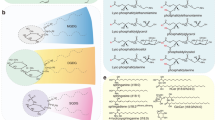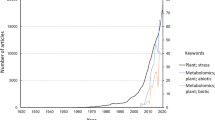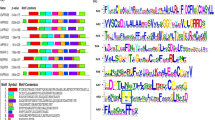Abstract
A high oleic acid rapeseed material M15 (derived from Xiangyou 15 variety) has been received more attention for its significant effect for human health. And it has almost the same physiological characteristic with Xiangyou 15 variety. To find out the difference between high oleic acid rapeseed material and Xiangyou 15 seedling, a comparative proteomic approach based on 2-DE and mass spectrometry was adopted. A total of 277 protein spots showed a significant change in intensity by more than 2.0-fold from M15 compared with Xiangyou 15 variety. Among them, 48 spots that changed at least 3.0-fold were excised from gels and successfully identified by MALDI-TOF/TOF MS. The identified proteins involved in metabolism of carbohydrate and energy (75%), stress and defense (8.3%), photosynthesis (6.3%), protein metabolism (2.1%) and other functions (8.3%). Then real-time quantitative PCR (qPCR) analysis was used to verify the expression levels of differentially expressed proteins, but the results did well agree with the proteomic results. In this work, most of the proteins involved in metabolism of carbohydrate and energy have higher expression in M15, which may reveal M15 has higher metabolism ability. These results provided much information to understand the differences between high oleic acid rapeseed material and Xiangyou 15 variety, which will be useful to screen high oleic rapeseed materials in seedling period.
Similar content being viewed by others
References
Allman F M A, Gomes K, Favaloro E J, Petocz P (2005). A diet rich in high-oleic-acid sunflower oil favorably alters low-density lipoprotein cholesterol, triglycerides, and factor VII coagulant activity. J Am Diet Assoc, 105(7): 1071–1079
Archie R P Jr. (2003). Rubisco activase-Rubisco’s catalytic chaperone. Photosynthesis Research, 75: 11–27
Bradford M M (1976). A rapid and sensitive method for the quantitation of microgram quantities of protein utilizing the principle of proteindye binding. Anal Biochem, 72(1–2): 248–254
Candiano G, Bruschi M, Musante L, Santucci L, Ghiggeri G M, Carnemolla B, Orecchia P, Zardi L, Righetti P G (2004). Blue silver: a very sensitive colloidal Coomassie G-250 staining for proteome analysis. Electrophoresis, 25(9): 1327–1333
Chen X, Truksa M, Shah S, Weselake R J (2010). A survey of quantitative real-time polymerase chain reaction internal reference genes for expression studies in Brassica napus. Anal Biochem, 405 (1): 138–140
David C J, John T R (1991). Development and characteristics of myrosinase in Brassica napus during early seedling growth. Physiol Plant, 82(2): 163–170
Delwiche C F, Palmer J D (1996). Rampant horizontal transfer and duplication of rubisco genes in eubacteria and plastids. Mol Biol Evol, 13(6): 873–882
Downs C G, Christey M C, Davies K M, King G A, Seelye J F, Sinclair B K, Stevenson D G (1994). Hairy roots of Brassica napus: II. Glutamine synthetase overexpression alters ammonia assimilation and the response to phosphinothricin. Plant Cell Rep, 14(1): 41–46
Falk A, Rask L (1995). Expression of a zeatin-O-glucoside-degrading β-glucosidase in Brassica napus. Plant Physiol, 108(4): 1369–1377
Ferro M, Salvi D, Brugière S, Miras S, Kowalski S, Louwagie M, Garin J, Joyard J, Rolland N (2003). PProteomics of the chloroplast envelope membranes from Arabidopsis thaliana. Mol Cell Proteomics, 2(5): 325–345
Fuller G, Diamond M J, Applewhite T H (1967). High-oleic safflower oil. Stability and chemical modification. J Am Oil Chem Soc, 44(4): 264–266
Green B R, Durnford D G (1996). The chlorophyll-carotenoid proteins of oxygenic photosynthesis. Annu Rev Plant Physiol Plant Mol Biol, 47(1): 685–714
Guan C Y, Liu C L, Chen S Y, Peng Q, Li X, Guang M (2006). A mutant of winter rapeseed (Brassica napus L.) with high oleic acid composition. Acta Agonomica Sinica, 32: 1625–1629 (in Chinese)
Guan M, Li X (2008). The studies of agronom ic characteristics of high oleic acid lines on rapeseed (Brassica napus). Chin J Oil Crop Sci, 30: 25–28 (in Chinese)
Guan M, Li X, Guan C (2012). Microarray analysis of differentially expressed genes between Brassica napus strains with high- and lowoleic acid contents. Plant Cell Rep, 31(5): 929–943
Horton P, Wentworth M, Ruban A (2005). Control of the light harvesting function of chloroplast membranes: the LHCII-aggregation model for non-photochemical quenching. FEBS Lett, 579(20): 4201–4206
Hua W, Li R J, Zhan G M, Liu J, Li J, Wang X F, Liu G H, Wang H Z (2012). Maternal control of seed oil content in Brassica napus: the role of silique wall photosynthesis. Plant J, 69(3): 432–444
Ishita A, Birgit H B, Magnor H, Bjørn I H, Caroline M (2011). Oilseed rape seeds with ablated defence cells of the glucosinolate-myrosinase system. Production and characteristics of double haploid MINELESS plants of Brassica napus L. J Ex Bot, 62(14): 4975–4993
Iwona R, Catherine E R, Dilip KN, Jones P J H. (2006). Phytosterols mixed with medium-chain triglycerides and high-oleic canola oil decrease plasma lipids in overweight men. Metabolism, 55(3): 391–395
Jansson S (1994). The light-harvesting chlorophyll a/b-binding proteins. Biochim Biophys Acta, 1184(1): 1–19
Jiang Y, Yang B, Harris N S, Deyholos M K (2007). Comparative proteomic analysis of NaCl stress-responsive proteins in Arabidopsis roots. J Exp Bot, 58(13): 3591–3607
Kamal A H M, Kim K H, Shin K H, Choi J S, Baik B K, Tsujimoto H, Heo H Y, Park C S, Woo S H (2010). Abiotic stress responsive proteins of wheat grain determined using proteomics technique. Aust J Crop Sci, 4: 196–208
Katayama H, Nagasu T, Oda Y (2001). Improvement of in-gel digestion protocol for peptide mass fingerprinting by matrix-assisted laser desorption/ionization time-of-flight mass spectrometry. Rapid Commun Mass Spectrom, 15(16): 1416–1421
Li X B, Fan X P, Wang X L, Cai L, Yang W C (2005). The cotton ACTIN1 gene is functionally expressed in fibers and participates in fiber elongation. Plant Cell, 17(3): 859–875
Liu C, Zhang Y, Cao D, He Y, Kuang T, Yang C (2008). Structural and functional analysis of the antiparallel strands in the lumenal loop of the major light-harvesting chlorophyll a/b complex of photosystem II (LHCIIb) by site-directed mutagenesis. J Biol Chem, 283(1): 487–495
Livak K J, Schmittgen T D (2001). Analysis of relative gene expression data using real-time quantitative PCR and the 2(-Delta Delta C(T)) Method. Methods, 25(4): 402–408
Lu W, Tang X, Huo Y, Xu R, Qi S, Huang J, Zheng C, Wu C A (2012). Identification and characterization of fructose 1,6-bisphosphate aldolase genes in Arabidopsis reveal a gene family with diverse responses to abiotic stresses. Gene, 503(1): 65–74
Mark A D, Jay T A, Michael D B (2001). Capturing value in the supply chain the case of high oleic acid soybeans. International Food and Agribusiness Management Review., 5: 87–103
Nancy A E (2002). Alternative splicing and the control of flowering time. Plant Cell, 14(4): 743–747
Ochs G, Schock G, Wild A (1993). Chloroplastic glutamine synthetase from Brassica napus. Plant Physiol, 103(1): 303–304
Portis A R Jr, (2003). Rubisco activase—Rubisco’s catalytic chaperone. Photosynth Res, 75(1): 11–27
Portis A R Jr, Parry M A J (2007). Discoveries in Rubisco (Ribulose 1,5-bisphosphate carboxylase/oxygenase): a historical perspective. Photosynth Res, 94(1): 121–143
Rask L, Andréasson E, Ekbom B, Ekbom B, Eriksson S, Pontoppidan B, Meijer J (2000). Myrosinase: gene family evolution and herbivore defense in Brassicaceae. Plant Mol Biol, 42: 99–113
Zoran R, Ivana M, Jianming F, Eduardo C, Benjamin P D (2007). Chloroplast protein synthesis elongation factor, EF-Tu, reduces thermal aggregation of rubisco activase. J Plant Physiol, 164(12): 1564–1571
Spreitzer R J, Salvucci M E (2002). Rubisco: structure, regulatory interactions, and possibilities for a better enzyme. Annu Rev Plant Biol, 53(1): 449–475
Robert J N, Benjamin W, Thomas A W, Patrick S, Garry H, Robert F (2004). Decreased aortic early atherosclerosis and associated risk factors in hypercholesterolemic hamsters fed a high-or mid-oleic acid oil compared to a high-linoleic acid oil. J Nutr Biochem, 15(9): 540–547
Ruuska S A, Schwender J, Ohlrogge J B (2004). The capacity of green oilseeds to utilize photosynthesis to drive biosynthetic processes. Plant Physiol, 136(1): 2700–2709
Salekdeha G H, Siopongcoa J, Wade L J, Ghareyazie B, Bennett J (2002). A proteomic approach to analyzing drought- and saltresponsiveness in rice. Field Crops Res, 76(2–3): 199–219
Jörg S, Fernando Gn, John B O, Yair S H. (2004). Rubisco without the Calvin cycle improves the carbon efficiency of developing green seeds. Nature, 432(7018): 779–782
Singh B N, Mishra R N, Agarwal P K, Goswami M, Nair S, Sopory S K, Reddy M K (2004). A pea chloroplast translation elongation factor that is regulated by abiotic factors. Biochem Biophys Res Commun, 320(2): 523–530
Stewart G R, Mann A F, Fentem P A (1980). Enzymes of gluiamate formation: glutamate dehydrogenase, glutamine synthetase, and glutamate synthase. In: Zn B J Miflin, ed: The Biochemistry of Plants, l5. Academic Press, San Diego, CA, 271–327
Xiao G, Wu X M, Guan C Y (2009). Identification of differentially expressed genes in seeds of two Brassica napus mutant lines with different oleic acid content. Afr J Biotechnol, 8: 5155–5162
Yan S P, Zhang Q Y, Tang Z C, Su W A, Sun W N (2006). Comparative proteomic analysis provides new insights into chilling stress responses in rice. Mol Cell Proteomics, 5(3): 484–496
Zavaleta M H A, Thomas B J, Thomas H, Scott I M (1999). Regreening of senescent Nicotiana leaves. J Exp Bot, 50(340): 1677–1682
Zhang Z Q, Xiao G, Guan C Y (2009). Determining biodiesel yield by gas chromatography inner standard method. Journal of the Chinese Cereals and Oils Association., 24: 139–142 (in Chinese)
Zhang Z Q, Xiao G, Liu R Y, Tan T L, Guan C Y, Wang G H(2011). Efficient Construction of a normalized cDNA library of the high oleic acid rapeseed seed. African Journal of Agricultural Research., 6: 4288–4292
Author information
Authors and Affiliations
Corresponding author
Rights and permissions
About this article
Cite this article
Zhang, ZQ., Xiao, G., Liu, RY. et al. Proteomic analysis of differentially expressed proteins between Xiangyou 15 variety and the mutant M15. Front. Biol. 9, 234–243 (2014). https://doi.org/10.1007/s11515-014-1311-5
Received:
Accepted:
Published:
Issue Date:
DOI: https://doi.org/10.1007/s11515-014-1311-5




